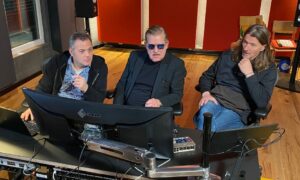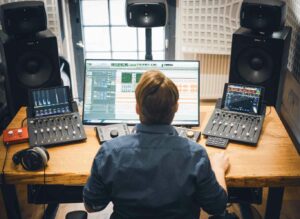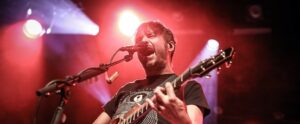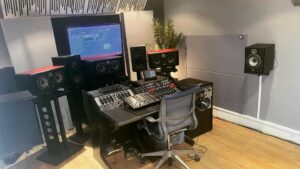
Max Cooper talks to us and Patrick from grobi.tv about his album Emergence as a holistic work of art. Dolby Atmos, the immersive sound concept of choice, is of course a must. Here is the link to the stream and afterwards the recording as video-on-demand. For those who prefer to read, here is the text summary of the interview with Max Cooper.
How did stereo develop into Dolby Atmos? Can you describe your perspective as a musician? You, in particular, have an interesting story, since you started out as a scientist.
Music has always been part of my life, but I always pursued science in school. I went into research and music was a hobby. At some point I discovered music production and became really addicted to it. I loved the opportunity to express myself, and I put a lot of work into it.
Then I got my PhD and got into the cycles of post-academic funding and that life was hard. And with music, by chance I got a few gigs and released some stuff and before I knew it, music took over my life. I’ve always had this love of nature, fine art, and scientific ideas, and at some point I just thought, why not try to combine those things.
Emergence was the first major project I put together this way. I started with the scientific concept of emergence and divided it into many chapters with different ways of looking at this concept.
In clubs and at festivals you have a live show, but the more I worked on it, the more I realized that this is something you can watch at home. So we did all the music videos and finally this Dolby Atmos experience.
My love of visual art translates musically as a love of spatiality in music. I love structure and form. And spatiality is a great way to literally present a structure or a form that you can have as a piece or sculpture, even on a sound level. And being able to experience this spatiality in auditory form is ultimately what brought me to this point in music.
What is the situation like for you at the moment because of the pandemic? Did you have time for new projects?
I haven’t played live in almost a year now, it’s crazy.
Work on the new album is almost complete. I have talked to many visual artists and mathematicians. The most fun part of these projects is usually collaborating with scientists and people outside of my musical field.
So I’ve been writing a lot of music and preparing a lot of things for when you can play live shows again. But I also put together a project with social distance in mind, which will take place in Belgium in a few months. So other opportunities have come up, new opportunities to present my art.
When did you first hear about Dolby Atmos?
I can’t remember when I first became aware of it. As a kid, I had cassettes with Dolby on them, so it was always in my head as a company. I knew they were the people who made high-end audio. At some point it probably came through my manager, he said he was in touch with Dolby and it just went from there. I built a very good relationship with the guys at Dolby in London and San Francisco. Also, I had already experimented with surround sound at that point.
The first spatial sound project I ever did was with 4D Sound. These guys are originally from Amsterdam, but are now based in Budapest. 4D Sound is another object-based system where you send sound to speakers and build three-dimensional structures and then map those structures. So I already had experience with this concept of taking a piece of music and imagining it as a physical structure and mapping it onto an object-based system. Dolby Atmos was a very natural transition for me.
Spatiality is as much a part of music as timbre or melody. You can put musical information into spatial structures and you can use spatiality to convey ideas. I use it as a means of expression, not just to do tricks.
I still think it’s an underused tool, you can do a lot more with it and it’s an exciting time to be part of it.
Does the visual come after the music? When you have visual ideas – do you ask other artists to visualize them?
No, I’ve moved more and more to having the visuals come first. I mentioned before that I’m talking to a lot of different people outside of music right now about ideas. What I like to do is develop a lot of visual ideas and stories first and then decide from that what the music should be. The visual ideas often come before the music. Not always, but I like to work that way. Although I am a musician, the visual is in many ways more fundamental to me than the music. I think about music in very visual terms, music has a certain structure and you can think of a piece of music as a structural unit.
What I’ve done for the last couple of albums has been to write down all these different ideas in a document and send them to visual artists to interpret. And sometimes they deliver very precisely and sometimes they have a different way of doing it and it’s better. There is no one-size-fits-all mechanism as I work with very different people, but I do start with a lot of visual ideas to root the process.
When I first saw you in Cologne, there were all these visual installations on the walls. Is that the case with every show? Are the visuals and the music the same on a tour?
I’ve developed a system where I map what I think works visually to what I think works with the music. I often collaborate with visual artists. They provide me with all this material, a lot of video clips and different layers. And then I have my audio side, again lots of audio clips, lots of layers, lots of effects and ways to recombine things in Ableton, and then I have Resolume, which does something similar for video clips. And I have many, many mappings. So if I adjust this frequency on this synth, I want the visual to adjust in this particular way.
The attempt is always there to work visually and whenever I can I do that. I do all the visuals myself. I have a system that can work with up to eight projectors, and I choose which visuals go on which surfaces. Basically, I can cover the whole room if we have the budget for many projectors, which is rare. Most of the time I do maybe three. It always depends on the venue, both musically and in terms of projectors. And also during the show I watch the audience to see what they like and what they don’t like, and that varies from country to country and from venue to venue. I need to be able to interact and change my set every moment to deliver what works. I was a DJ before I became a music producer, so I still have the ethos of wanting to interact with people and give them what they want and I want.
At the impressive show in Cologne with all the visuals, I was thinking about Dolby Atmos. Is that something you’re working on? How do you see the future of Dolby Atmos at live shows?
That’s something I’ve talked to Dolby about quite a bit. Yes, there are clubs that have already installed Atmos systems. Unfortunately, the clubs that installed them have no way to stage a visual show. There are only about a handful of clubs in the world that have an Atmos system. At least that was the case when I last heard about it. And so far I haven’t been able to find a combination of Atmos and a visual show, but I’m sure that will happen eventually as more clubs move to spatial systems. I hope that will happen.
I have also tried some other types of spatial sound. For example, I played a homemade spatial sound show at Berghain, with only six channels. So not object-based, not particularly sophisticated, but in a club environment it’s quite nice to have some really raw points to get the big drum sounds from different positions. This can be quite effective.
This is quite different from the subtle beauty that can be achieved with a fully object-based Dolby Atmos system in a beautiful acoustic space. So I’ve been experimenting with some club-based surround sound shows, but I haven’t managed to merge the visual shows and the spatial audio yet. Basically, I’m still waiting for the venues. And with spatial audio, there’s a little bit of a limitation on the size of the shows because you get a delay. So if you have a big space, the delay is so much for one side to the other that the rhythms can get hugely affected by distances from the different speaker points. In the end, this is also a question of budget and construction for the respective location.
But it’s moving in the right direction, it will happen for sure.
Will your new album also be a Dolby Atmos product?
I don’t know yet, that’s something I haven’t worked out.
My label is called Mesh and they have a Dolby Atmos album coming from another artist, and it hasn’t actually been officially announced yet, so this is the first news of it. It’s coming pretty soon. Certain streaming services have Dolby Atmos, I believe the higher tiers from Tidal and Amazon as well. Actually, it took us a long time to get the distribution system in place to do that as an independent label. It was not possible to upload and digitally distribute Dolby Atmos until recently. The album is by Reid Willis, he’s a really amazing producer and his stuff is mind blowing. It’s very cinematic, amazingly punchy and precise and really expressive and harmonically really interesting as well. His work is really high-end and well suited to this format.
At the moment there is only the digital release planned.
Many people have a home theater system at home and like to have the product in their hands. What is your opinion as an artist on physical media?
I buy 4k Blu-rays with Dolby Atmos when I really love a movie. I want the full experience. I can’t get that quality from streaming.
For me personally I’m all about high fidelity and I spend so much of my time working on all these tiny details that you don’t hear unless you have a good high fidelity system.
I love that side of things, it really engulfs me and consumes me and that’s why I keep working. But I also write my music in a way that will work on a club system or will sound okay on an iPhone speaker. The way I mix music in my approach there’s a really simple underlying core. A kick drum and a base line maybe and some simple synth element. That’s quite clean and will come across on any system and on that I build more and more layers on top. I try to optimize across the board. I don’t want my music to be only accessible for people that have all that stuff.
The better of a system you listen on the more you will find in there. The closer you look the more you find – a bit like Jackson Pollock painting. I love that sort of fractal structure, because that is the way nature is structured and I love that for music as well.
When you listen to high quality music is this in your studio or do you also have a space at home?
Surely for listening to music the best place is in my studio.
I have a very basic Dolby Atmos system in my living room. A soundbar with two satellite boxes that also throw the sound to the ceiling. But in terms of sound quality, it doesn’t compare to proper studio monitors of course or really high-end cinema stuff.




